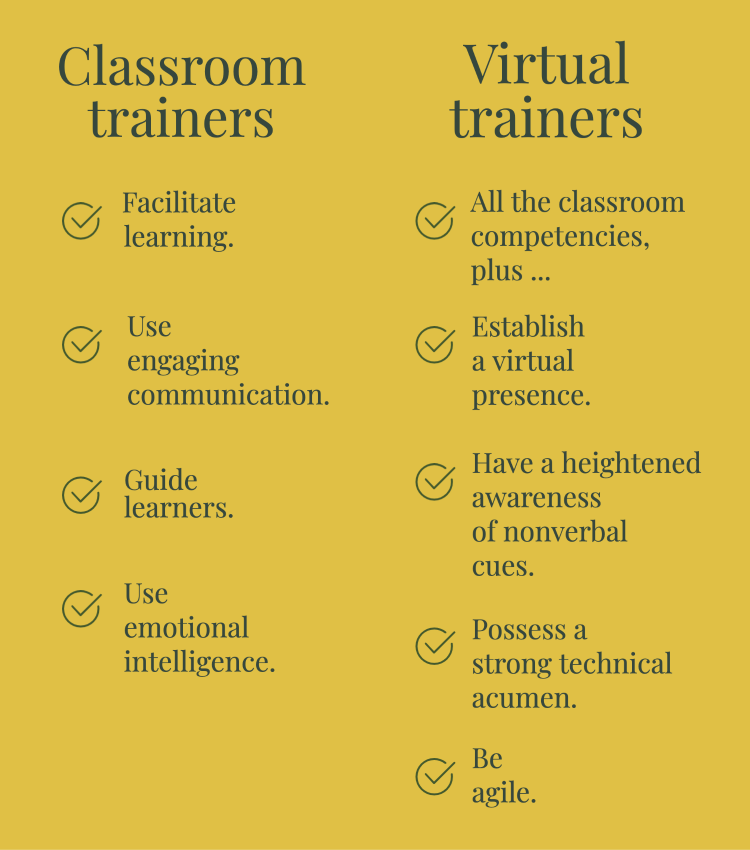
It’s up to you to make virtual learning and development a flourishing part of your organization's learning culture — because it’s here to stay.
by Verity Creedy
November 16, 2020
Have you recently watched a movie or tv show where characters embrace, but they don’t live together or aren’t in some sort of “protective bubble?” Do you find yourself frowning at them or gasping in horror at their inappropriate pandemic behavior? But then you remember they’re “normal,” and right now we’re the exception.
Recently, I had a conversation with a leadership and development director that went like this: He recalled the days when you could just walk around a training room and engage, face-to-face, with learners. He could easily gauge whether the program content was connecting with learners and give the appropriate attention to those flying ahead or straggling behind.
He asked me if it would be normal again one day, but I struggled to say “yes.” Honestly, I am not sure training will ever go back to pre-2020 physical classroom levels. Virtual development will forevermore be a reasonable option. It won’t be a compromise, but a practical, cost-efficient, multi-location-friendly alternative.
Adding to this dynamic is the fact that the need for high-quality leadership and team training hasn’t changed. On the contrary, prior to the pandemic, 70 percent of professionals worked remotely at least once a week, according to a 2018 survey. And now a lot more are working remotely. But a DDI study found that leaders rank virtual leadership as their weakest skill. In fact, one in four leaders said they aren’t at all effective at leading a virtual team.
Furthermore, a DDI study of more than 15,000 leaders showed that levels of leadership confidence are scarily low when it comes to critical skills. Only 30 percent feel they are effective at making change happen, while even fewer feel they managed to help others accept change. In addition, only 25 percent feel they are effective at leveraging new technology, and a mere 18 percent are prepared to help their team avoid burnout. This reveals a burning need for leadership development to quickly adapt and upskill to remain effective and productive.
So, perhaps I shouldn’t have been surprised that when I shared this, my colleague gulped slightly and I could see the color drain from his face, even on a video call. We moved on to how to get ready for this new normal in training.
Moving forward, learning and development leaders need to consider these five things as their next steps to remain focused on embracing a virtual training platform.
1. Do something.
It’s astonishing to see how many leaders reported that their development programs and opportunities were halted altogether during the pandemic. It’s equally astonishing to realize they were offered online libraries as their primary source of development.
It’s easy to see the learning and development side of this — it’s a cheap and scalable way to offer skill support. However, when you look at these top criticisms of leadership development, you can see why these solutions are not having the desired impact. Some of the most common complaints from learners include:
- I don’t get enough learning from peers and colleagues.
- It isn’t practical or applicable.
- It’s boring or disengaging.
- It’s not relevant.
There are multiple virtual development solutions for leaders and teams to avoid all these criticisms. They include formal training in a virtual classroom led by facilitators, practice lab facilitated sessions to practice crucial skills with colleagues, and one-on-one or small group peer coaching. This could also include business roundtables, led by a senior leader, to discuss pressing challenges facing teams. Whatever your development need, any acceptable time to pause has now expired. You need to choose a virtual approach and get moving.
2. Get virtual delivery right.
You have tried-and-tested material from in-person development, so you just put it onto slides, right? Wrong! In a virtual format, leaders and teams need more breaks, engagement, collaboration, and chances to walk away from the screen and reflect. There are some tools that we have found to be “must haves,” such as whiteboards, polling questions, chat, emoticons, break-out rooms and facilitator drop-ins. You need to find the technology that your company can and will support wide-scale and then focus on its features. This is important because you need to design all of your virtual development content to leverage those features. Remember that learner criticism of “boring or disengaging” development? You need to get the content and technology right to mitigate this risk.
3. Your past A-team might not be your future lead players.
This is a tough one. If I was to ask you who your best trainers are in a traditional classroom setting, I bet you could list them off in a few minutes. But the terrifying truth is that these are probably not the people you need leading your virtual development charge. Virtual development can be just as effective, if not more so, as traditional classroom development. But it requires a very different skill set. A job description comparison might look something like:

Remember, there is no set timeline as to when leaders and teams will be back in traditional office settings on a regular basis. Even when they do return, it’s likely that virtual development will be leveraged far more often, so investing in this skill set now is an investment in your long-term learning and development capability.
4. Turn down technical issues, turn up engagement.
You have chosen where to start, selected great technology, drafted strong virtual content and developed an army of solid virtual trainers. From my experience, that’s still not enough to guarantee your leaders and teams receive superb virtual development.
You need focused learners, but technology issues are emerging. Or feelings of isolation are kicking in. One learner cannot find the document the trainer is referencing, and engagement is starting to dip. All of these issues highlight the importance of a producer who serves as the facilitator’s right hand throughout any virtual training. A producer allows the facilitator to focus on transferring knowledge and engaging learners. The producer ensures learners are all leveraging the digital tools, while being productive and keeping motivated.
Specifically, we see the producer complete several activities, including:
- Providing links and set-up instructions to learners.
- Sharing any materials, in advance or on the spot.
- Managing all technical issues during sessions, from giving an overview of how to use the platform to troubleshooting any issues users encounter.
The producer is ultra-agile, calm under pressure and technologically savvy. They almost remove technology from the experience by making the whole development event so smooth that it’s as simple as walking into a classroom.
5. It takes a village.
This really isn’t unique to virtual development but seems to be even more important in today’s development landscape. It is affecting the attendance, motivation and behavior change of your leaders and teams. There are a couple of specific audiences to consciously engage and questions to ask yourself:
- Managers of learners: How does their support look different with your alternate modality and form of development? Are you successfully sharing an overview of what the leaders and teams are learning and how they can actively reinforce that learning?
- Senior stakeholders: There are competing priorities in businesses right now and it can be so tempting to allow leadership development to get bumped off the agenda. How can you silence any skepticism and quickly demonstrate the return on investment?
HR analyst Josh Bersin once said, “The single biggest driver of business impact is the strength of an organization’s learning culture.”
Show me a business today that is not looking to drive more impact. Businesses booming with opportunities are trying to maximize each one, while those negatively affected by the business landscape are required to quickly pivot their strategy in a new direction.
Whichever category your organization falls into, creating a strong learning culture will be beneficial. It’s up to you to make virtual development a flourishing part of that learning culture — because virtual is here to stay. Embrace it.



